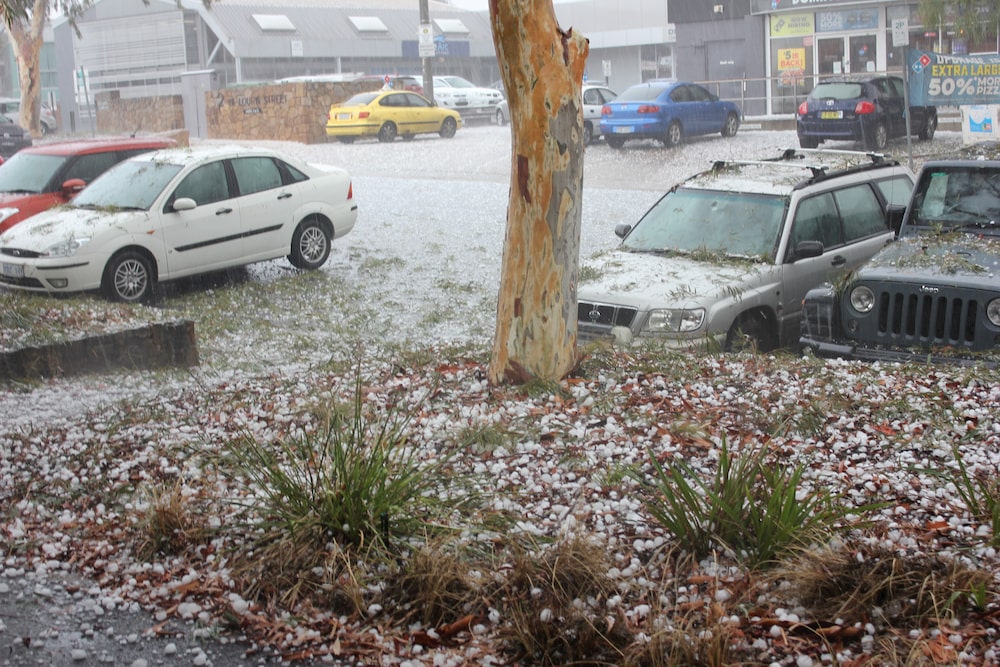A year ago today, Canberra suffered the worst hailstorm to hit an Australian city since the Sydney storm of 1999. It was a deluge of almost Biblical proportions: the storm lasted only 15 minutes, but in that quarter of an hour, $638 million worth of damage was inflicted.
Winds up to 117km an hour flung hailstones the size of golf balls into the defenceless city, smashing windows, bringing down powerlines, toppling trees, flooding buildings, and denting cars.
Frantic Canberrans made more than 2,500 requests to the ACT Emergency Services Agency (ACTESA) for help – triple the yearly average. More than 44,000 vehicles were damaged, 7,500 of them uninsured.
CSIRO glasshouses were smashed, and crop research that had taken years was ruined in an instant. The Australian Academy of Science’s Shine Dome and Ian Potter House also suffered the fury of the storm. One might think some vengeful thunder god was wreaking havoc on science, were it not that St Nicholas Greek Orthodox Church and St Andrew’s Church in Forrest were also struck.
At a press conference at the ACTESA HQ this morning, politicians and emergency service personnel looked back proudly on their efficiency that difficult day.
ACT Minister for Police and Emergency Services, Mick Gentleman, said the event “showcased the resilience of Canberrans and the effectiveness of our emergency services”.
For ACTESA Commissioner Georgeina Whelan, the agency’s response vindicated its model: the ACT Ambulance Service, ACT Fire & Rescue, ACT Rural Fire Service, and the ACT State Emergency Service (SES) working collaboratively to manage emergencies the Territory faced.
“The versatility of ACTESA and its four services to oscillate from fire to storm and flood in a 24-hour period is a testament to our staff and volunteers,” she said.
Cleaning up streets, getting traffic and people moving, and reassuring the community were priorities for the ACT SES, chief officer Anthony Draheim said. The ACT SES were aided by their NSW colleagues and other ACT agencies.
ACT government crews helped the emergency services to clean up the city over the next week. Even by the next day, a government spokesperson said, debris had been cleared from major shopping centres, district parks, showgrounds, pathways, and drains.
Danielle Brennan, a Woden SES member, said she had not seen anything like the hailstorm in her two years of volunteering.

She remembers driving down her street, and seeing leaves blown everywhere; cars smashed; and tarps on all the houses.
“It looked a bit of a circus town for a few weeks there.”
Ms Brennan was at work when she received the text message to say she had been activated. She went straight from work to spend several hours dealing with broken tiles and skylights, and water coming into houses.
“It was a pretty hectic day.”
Ms Brennan said she learnt how to pace herself in an emergency, and to rely on her team. They quickly became efficient in setting up heights safety systems. “We put one of them up every time we’d go on a roof; we were practising it multiple times per day.”
Thankfully, Ms Brennan said, she was not affected by the hailstorm.
“I panicked and moved my car undercover when I heard the hailstorm was coming. It was lucky that I was able to. Not many people were. A few friends had their cars written off, or their houses affected.”
La Niña weather events tend to bring heavy rainfall, while storms and flash flooding are expected. But the ACTESA is prepared, Ms Whelan and Mr Draheim said.

Over the last year, the agency’s 900 staff and more than 2,000 volunteers have taken part in a preparedness and training program, based on a review of their response last year.
The ESA has pioneered an “all-hazards” approach to emergency management: all the aspects of the agency can work together on different aspects of the storm and fire season, Mr Gentleman said.
The ACT government, the Minister continued, has also invested in additional volunteers, vehicles, and training in the last year to enhance its storm-response capabilities. The government also helped Canberrans cover fees and charges they incurred for damaged vehicles, providing 7,600 rebates worth more than half a million dollars.
While the ACTSES is prepared to respond to storm and flood damage, Ms Whelan urged Canberrans to prepare their homes and properties for storms and other emergencies. The ACTESA has an emergency survival plan on their website.
“So far, [the storm season has] been pretty okay,” Ms Brennan said. “Fingers crossed it’s definitely not like the hailstorms last year!”
More news:
- ‘Don’t forget us’: Unions call for teachers to be added to vaccine priority list
- Let Mimi walk: Petition to change ACT cat containment laws
- Story time with Canberra’s newest children’s author Amelia McInerney
- ACT ends mandatory quarantine for Northern Beaches
- Hazardous surf conditions to impact the NSW coast



